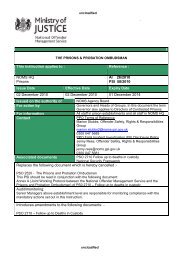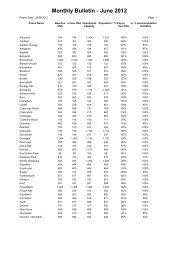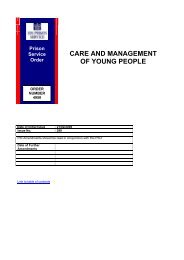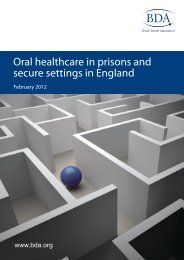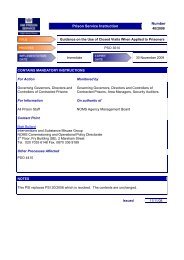Oral Health in Scottish Prisons - Inside Time
Oral Health in Scottish Prisons - Inside Time
Oral Health in Scottish Prisons - Inside Time
Create successful ePaper yourself
Turn your PDF publications into a flip-book with our unique Google optimized e-Paper software.
Dentists and dental teams <strong>in</strong>volved <strong>in</strong> the treatment of prisonersand those <strong>in</strong> secure sett<strong>in</strong>gs must be supported to provide thelevels of care needed by their populations.What is the problem?Provid<strong>in</strong>g dental services <strong>in</strong> a prison environment presents dentists with many unique challenges,<strong>in</strong>clud<strong>in</strong>g concerns about threats to personal security, <strong>in</strong>ability to move freely, and the requirementsto deliver modern dental services <strong>in</strong> an environmentthat, <strong>in</strong> many cases, requires modernisation. Muchof what is taken for granted <strong>in</strong> high street practicesmay be difficult to implement, while on the otherhand practitioners f<strong>in</strong>d themselves bound by anadditional prison rule book. Ensur<strong>in</strong>g compliancewith decontam<strong>in</strong>ation and other cl<strong>in</strong>ical guidel<strong>in</strong>es <strong>in</strong> a prison environment with its strict securityprocedures, for example, represents an unusual, and not <strong>in</strong>significant, challenge.Why is it a problem?Prisoner profileSecure sett<strong>in</strong>gs are prisons,young offenders’ <strong>in</strong>stitutes andsecure psychiatric hospitals.<strong>Prisons</strong> <strong>in</strong> Scotland are runn<strong>in</strong>g at high capacity. Accord<strong>in</strong>g to the Auditor General for Scotland“prisoner numbers have <strong>in</strong>creased significantly s<strong>in</strong>ce 2000/01, with the highest ever number of7,700 recorded <strong>in</strong> April 2008. The number of prisoners is projected to <strong>in</strong>crease by almost 20 percent by 2016/17” (Audit Scotland 2008:05).Many prisoners suffer from mental health issuesor learn<strong>in</strong>g difficulties, a higher proportion than thegeneral population (Department of <strong>Health</strong> (England)2003:06). The prison population is a high needs yetvulnerable group with complex oral health needs whichcan be complicated by drug and alcohol addictionand dependence problems. In 2007, the World <strong>Health</strong>Organisation reported that “prisoners with substancemisuse problems are likely to report toothache verysoon after enter<strong>in</strong>g prison, as any opiate drugs they tooksuppressed the toothache” (2007:148). In support<strong>in</strong>gprisoners through drug and alcohol rehabilitationprogrammes, the dental team is well placed to be partof the multi-discipl<strong>in</strong>ary healthcare team.An age<strong>in</strong>g populationThe already complex needs of the prison population are exacerbated as prisoners enter old age.The prison environment has a significant impact on prisoners’ general health, mean<strong>in</strong>g thatprisoners may be 10-15 years olderphysiologically than those of the same ageoutside prison. In addition, older prisonerssuffer accelerated biological age<strong>in</strong>g, whichhas severe implications on oral as well asgeneral health (National Association ofPrison Dentistry UK 2010:1).In the last ten years, the number of sentencedprisoners over 60 <strong>in</strong> England and Wales hasgrown by almost 250 per cent” (Hayes &Shaw 2011:38). Heath and Iqbal report that“it is recognised that the prison populationis generally from marg<strong>in</strong>alised communitiesthat have poor access to primary healthcare”(2007:42). This comb<strong>in</strong>ation, of the age<strong>in</strong>g prisoner and poor access to healthcare <strong>in</strong> earlier lifebr<strong>in</strong>gs additional challenges to an already stretched prison healthcare system.Prison facilities and the provision of servicesI recently met a woman<strong>in</strong> Holloway who hadassaulted a member ofstaff and it turned out she had doneit deliberately to prolong her stayas she was mid-way through dentaltreatment and it was the first timeshe had been to a dentist.”Crook 2009:31The prison environment often presents additional barriers to the delivery of appropriate and effectivecare to an already high needs population.The prison population often present with high needs, as emergency and urgent cases, and accessor follow<strong>in</strong>g through with care as a prisoner isn’t always easy. The high turnover of prisoners <strong>in</strong>some <strong>in</strong>stitutions, particularly <strong>in</strong> remand or short-stay <strong>in</strong>stitutions, where short sentences or frequenttransfers between facilities mean courses of treatment can go unf<strong>in</strong>ished. When prisoners aretransferred between facilities, this has implications for the oral and general health of the patient, theworkload of the receiv<strong>in</strong>g dentist at theWhile treat<strong>in</strong>g this particularpopulation provides many<strong>in</strong>terest<strong>in</strong>g challenges,theproblems of provid<strong>in</strong>g efficienthealthcare with<strong>in</strong> the many restrictionsimposed by the prison system canmake it a frustrat<strong>in</strong>g experience.”Dr J Husband 2010next <strong>in</strong>stitution and the additional cost tothe NHS of commenc<strong>in</strong>g a new courseof treatment where dental records arenot transferred with the patient. On 12April 2011, the Department of <strong>Health</strong> <strong>in</strong>England issued a press release aboutthe improvements <strong>in</strong> prison health as aresult of a national IT system <strong>in</strong> prisonsand young offenders’ <strong>in</strong>stitutes. Theproject aims to improve cont<strong>in</strong>uity ofcare for prisoners mov<strong>in</strong>g betweenprisons because of the <strong>in</strong>stallation ofa new system conta<strong>in</strong><strong>in</strong>g up to date medical <strong>in</strong>formation, thus liberat<strong>in</strong>g cl<strong>in</strong>icians to concentrateon patient care. We hope that any advancements <strong>in</strong> IT <strong>in</strong> Scotland will mean improved transfer ofdental patient records, provid<strong>in</strong>g that the new technology can be <strong>in</strong>tegrated <strong>in</strong>to exist<strong>in</strong>g IT systems.








